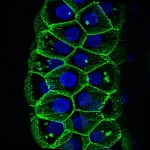(Press-News.org) A study of over 10,000 children in rural Pennsylvania revealed that a large proportion of children were fed foods that are high in sugar and salt in their first years of life.
Over half (53%) of the children in the study received high-sodium meats such as hot dogs, 37% received salty snacks such as potato chips, and one-third (34%) received cakes, cookies, or pudding before age 2. In addition, over one-quarter (27%) of babies received juice before their first birthday.
“Given that these foods are not recommended for children, these numbers are concerning,” said Carolyn F. McCabe, PhD, staff scientist in the Department of Population Health Sciences and the Center for Obesity and Metabolic Research at Geisinger. “Early exposure to foods and beverages high in sugar, fat, and sodium can potentially have negative consequences for the healthy growth and development of infants and children.”
McCabe will present the findings at NUTRITION 2023, the flagship annual meeting of the American Society for Nutrition held July 22–25 in Boston.
Current U.S. dietary guidelines recommend waiting until at least age 1 to introduce 100% fruit or vegetable juices, and that families avoid foods and beverages with added sugars and limit those high in sodium for children younger than 2. These recommendations are designed to lower the risk of overweight and obesity, diabetes, asthma, and other chronic health conditions.
According to experts, exposing young children to overly sweet or salty foods can shape their taste preferences and lead to unhealthy eating habits in the long term.
“Early life is such a critical period for establishing eating habits and food preferences, and these preferences and behaviors around food can persist as children grow,” said McCabe. She added that early exposure to these foods may mean some children are not getting enough of the healthy foods they need for proper nutrition. “Infants and toddlers have small stomachs, so it is important to make every bite count.”
For the study, researchers analyzed questionnaires given at well-child visits for 10,614 children up to 26 months of age who visited Geisinger, a rural-serving health system in Pennsylvania between 2016-2020. In addition to early introduction of foods high in sugar, fat, and sodium, the study revealed that less than half (46%) of babies exclusively consumed human milk and/or formula for the first six months of life as dietary guidelines recommend. Twenty-nine percent of children received sweetened cereal and 1 in 10 received sugar-sweetened beverages before age 2.
Children living in rural areas face many health and socioeconomic disparities. One in 5 rural children live in poverty and children in rural areas are 25% more likely to experience obesity compared with nonrural children. These disparities make it even more important to ensure rural families are aware of dietary guidelines for children and have the resources they need to follow them, McCabe said.
McCabe will present this research at 9 a.m. on Sunday, July 23, during the Milk to Meals: Feeding from Birth to Childhood Oral Session in the Sheraton Boston, Constitution B (abstract; presentation details).
Please note that abstracts presented at NUTRITION 2023 were evaluated and selected by a committee of experts but have not generally undergone the same peer review process required for publication in a scientific journal. As such, the findings presented should be considered preliminary until a peer-reviewed publication is available.
About NUTRITION 2023
NUTRITION 2023 is the flagship meeting of the American Society for Nutrition and the premier educational event for nutritional professionals around the globe. NUTRITION brings together lab scientists, practicing clinicians, population health researchers, and community intervention investigators to identify solutions to today’s greatest nutrition challenges. Our audience also includes rising leaders in the field – undergraduate, graduate, and medical students. NUTRITION 2023 will be held July 22-25, 2023 in Boston. https://nutrition.org/N23 #Nutrition2023
About the American Society for Nutrition (ASN)
ASN is the preeminent professional organization for nutrition research scientists and clinicians around the world. Founded in 1928, the society brings together the top nutrition researchers, medical practitioners, policy makers and industry leaders to advance our knowledge and application of nutrition. ASN publishes four peer-reviewed journals and provides education and professional development opportunities to advance nutrition research, practice, and education. Since 2018, the American Society of Nutrition has presented NUTRITION, the leading global annual meeting for nutrition professionals. http://www.nutrition.org
Find more news briefs from NUTRITION 2023 at: https://www.eurekalert.org/newsroom/nutrition2023.
###
END
Systematic review of 8 studies in more than 7,700 serodiscordant couples in 25 countries finds people living with HIV with viral loads less than 1,000 copies/mL have almost zero risk of transmitting the virus to their sexual partners. Previous studies have not been able to confirm a lack of transmission risk above 200 copies/mL.
Systematic review also consolidates and reinforces previous studies that have found there is zero risk of transmitting the virus to sexual partners when people living with HIV have an undetectable viral load.
Of the more than 320 documented sexual HIV transmissions ...
In one of the first large-scale studies of genes related to diet, researchers have uncovered almost 500 genes that appear to directly influence the foods we eat. The findings represent an important step toward using a person’s genetics to develop precision nutrition strategies that help improve health or prevent disease.
“Some genes we identified are related to sensory pathways — including those for taste, smell, and texture — and may also increase the reward response in the brain,” said research team leader Joanne Cole, PhD, assistant professor in the Department ...
There is growing evidence that consuming prebiotics — certain types of fiber often found in plants that stimulate beneficial bacteria in your gut — can help to maintain a healthy gut microbiome. In a new study, scientists estimated the prebiotic content of thousands of food types by using preexisting literature to find out which foods offer the highest prebiotic content.
According to the study, foods that pack the greatest prebiotic punch are dandelion greens, Jerusalem artichokes, garlic, leeks, and onions. In addition to supporting gut microbes, prebiotic rich ...
A University of Texas at Arlington engineering researcher is working on defenses that could thwart cyberattacks against networks of self-driving cars and unmanned aerial vehicles.
Animesh Chakravarthy, associate professor in the Department of Mechanical and Aerospace Engineering (MAE), is the principal investigator on an approximately $800,000 U.S. Department of Defense grant titled “Resilient Multi-Vehicle Networks.” MAE Professor Kamesh Subbarao, and Bill Beksi, assistant professor ...
Using electrochemistry to separate different particles within a solution (also known as electrochemical separation) is an energy-efficient strategy for environmental and water remediation: the process of purifying contaminated water. But while electrochemistry uses less energy than other, similar methods, the electric energy is largely derived from nonrenewable sources like fossil fuels.
Chemists at the University of Illinois Urbana-Champaign have demonstrated that water remediation can be powered in part — and ...
Millions of deaths and ongoing illnesses caused by the COVID-19 pandemic have prompted scientists to seek new ways of understanding how viruses so skillfully enter and reprogram human cells. Urgent innovations leading to the development of new therapies are needed since virologists predict that future deadly viruses and pandemics may again emerge from the coronavirus family.
One approach to developing new treatments for such coronaviruses, including the SARS-CoV-2 virus that causes COVID-19, is to block the mechanisms by which the virus reprograms our cells and forces them to produce more viral particles. But studies have identified nearly 1,000 human proteins ...
The worms that cause schistosomiasis (Schistosoma mansoni) are unusual in several ways, especially the fact that male and female adults must stay paired together throughout their lives for reproduction to be successful. Females may produce as many as 3,000 eggs per day. Approximately half reach the host’s gut or bladder. The rest are swept away via the blood to the liver and spleen, where they cause severe inflammation and liver cirrhosis, the main cause of mortality.
Researchers at Butantan Institute ...
Researchers have identified a number of chokepoints in U.S. agricultural and food supply chains through a study that improves our understanding of agri-food supply chain security and may aid policies aimed at enhancing its resilience. The work is presented in a paper published in the July 20, 2023, issue of the journal Nature Food, “Structural chokepoints determine the resilience of agri-food supply chains in the United States,” by authors including CEE Associate Professor Megan Konar and CEE Ph.D. student Deniz Berfin Karakoc.
The agricultural and food ...
The Spallation Neutron Source at the Department of Energy's Oak Ridge National Laboratory set a world record when its particle accelerator beam operating power reached 1.7 megawatts, substantially improving on the facility’s original design capability.
The accelerator’s higher power provides more neutrons for researchers who use the facility to study and improve a wide range of materials for more efficient solar panels, longer–lasting batteries and stronger, lighter materials for transportation. The achievement marks a new operational milestone for ...
The National Institute of Allergy and Infectious Diseases (NIAID), part of the National Institutes of Health, has awarded five projects for research to better understand Post-treatment Lyme Disease Syndrome (PTLDS), which is a collection of symptoms, such as pain, fatigue, and difficulty thinking or “brain fog,” which linger following standard treatment for Lyme disease. The Centers for Disease Control and Prevention estimates that 476,000 people in the United States are infected with Lyme disease each year. Between 10 and 20% of ...




